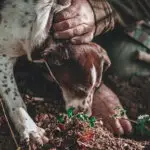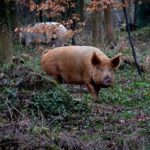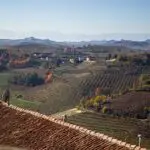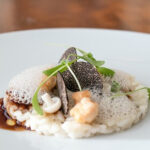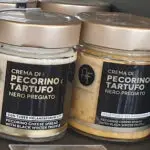Truffle hunting is akin to digging for gold; it’s difficult, it requires a lot of skill, and truffle cultivation can be especially profitable when successful. That said, any individual who wants to learn to hunt truffles can do so provided they follow the rules of the trade.
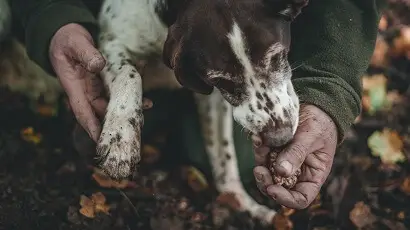
Truffle hunting is not a casual pastime; it’s a business that is taken seriously by truffle hunters. There’s a lot to know about where to find truffles and what tools to utilize to make the process easier. Since these mushrooms are so valuable in the culinary world, having connections to sell truffles to is often necessary to make use of these delicious treasures.
While truffles grow naturally, these delicious and fragrant mushrooms are extremely rare.
The Profession Of A Truffle Hunter
For those living in regions where truffles grow, truffle hunting can be a worthwhile and even lucrative profession. Truffle hunters have developed their own tricks and best practices to help them find truffles. Furthermore, truffle hunters have to become trained and certified to legally find truffles.
Before you set off to hunt some fresh truffles, it’s important to understand that a lot of regions where these mushrooms grow have some pretty strict rules regarding truffle hunter practices. Collecting truffles is so highly regulated because they can only grow in certain areas under specific conditions, so they are not available in excess.
Truffle farms are a relatively new way to cultivate truffles, especially in regions where they don’t naturally occur in the wild. Of course, these farms deter from the joy of the hunt, and the quality of truffles found on these farms is nowhere near mushrooms harvested in the wild.
What Regions Do Truffles Grow In?
Wild truffles can be difficult to find and they only naturally occur in a few regions. Truffles are most commonly found in European countries. However, the Pacific Northwest region of the United States, including states like Washington and Oregon, is also home to some truffle species.
Those who hunt for Europe truffles can’t necessarily travel to the Pacific Northwest to find truffles. Certification requirements can vary by region, meaning another license will likely be required.
Basic Rules Of Truffle Hunting
There are some very specific ways that truffle hunters do their work depending on where they hunt. That said, no matter the species of truffle one is hunting for, a few basic rules of truffle hunting apply just about everywhere.
Truffles Grow On Trees – Sort Of
Truffles tend to aggregate around specific trees. This is because truffles and trees have a symbiotic relationship; truffles need those trees’ roots in order to grow. Truffles grow from beech trees, pine trees, fir trees, oak trees, and black pine trees.
Some specific types of trees and plants known to host mushrooms include the downy oak tree, the turkey oak, and black hornbeams. Many of these trees are planted in clayey and calcareous soils, making them easier to dig through.
You Need To Know The Land
Experienced truffle hunters and truffle collectors get to know everything they can about the region they hunt in. Often, truffles are found in forested areas given the vast number of trees. One gets to know the host plants of truffle species, every element of the surrounding soil, the truffle growing process, and weather patterns in the area.
Have The Right Tools
Since you’ll have to do some digging to find truffles, you’ll need to have a few tools with you. A rake can be an excellent way to sift through the soil to collect truffles. In Italy, there’s a specific type of spade and hoe used to dig for truffles without harming roots. You’ll also want to have a light source with you; preferably one that’s hands-free.
What You Should Know Before You Start Looking For Truffles
Once you’re set up with the appropriate training and licenses to go find truffles, there are some not-so-hidden secrets of the trade to know before you set off on your first hunt.
Rodents Love Truffles Too
Small rodents can smell these aromatic mushrooms and if they find them, they’ll eat the truffles. Regardless, they often leave evidence behind that you can use when truffle hunting such as small holes.
The Smell Of Truffles
Unless you have a very keen nose, you likely won’t be able to smell a truffle until you hold it up to your nose. However, understanding the fascinating science behind the aroma of truffles can be helpful when you are deciding how to approach collecting truffles.
Truffles contain what are known as fruiting bodies that animals and plants are able to detect. These fruiting bodies are what cause truffle spores to be released into the soil to germinate and potentially lead to new truffles growing in the area.
Signs To Look For When Truffle Hunting
Having good eyesight and refined attention to detail are some of the best tools you can have to find truffles.
Wet Soil
Damp soil conditions can make it easier to unearth truffles. They grow underground and often require lots of digging to uncover, so the dampness can make this process much easier. Typically, a week or two after lots of rain produces the ideal dampness.
Brown Spotting
Even though truffle growth is all underground, the soil will often develop brown spots above where truffles can be found. The coloring is usually slightly darker than the soil. This can help you focus on where to start digging for these underground mushrooms.
Witch Circles
Witch circles are areas of dead or stagnant plant life that often form around where black truffles can be found. Essentially, this is because the truffle spores make it impossible for other plants to grow nearby.
How To Find Truffles
Anyone who has witnessed a truffle hunt knows that truffle hunters don’t often go out on their own.
The Truffle Dog
Truffle dogs are often utilized for their sense of smell which can assist truffle hunters with finding truffles. Furthermore, these dogs are trained to identify truffles that are still ripe and can be consumed. While it can be difficult, you can employ dog trainers that can teach your dog how to locate truffles.
A well-trained dog has been the preferred hunting companion for truffle hunters for decades, especially since they won’t try and eat truffles once they help sniff them out. Various dogs are utilized for this purpose, but the Springer Spaniel is a popular breed for this purpose.
Truffle Pigs
Pigs also have a great sense of smell and used to be utilized by truffle hunters for a long time. However, since pigs are prone to eat the truffles once they’ve been dug up, dogs tend to be the preferred companion animal during truffle hunts. Truffle hunting with pigs is now illegal in most regions despite their good nose.
Truffle Fly
It’s a good idea to recognize and memorize what a truffle fly looks like as they can often be found around areas where truffles are growing underground. Some hunters even utilize truffle flies during their hunt, as they will gravitate towards ripe truffles in order to lay their eggs nearby.
Where To Find Different Types Of Truffles
Truffles found in one region of Europe aren’t the same as truffles found in Oregon. You might have to move around and get certified to hunt other truffle species in other regions depending on what you’re looking for.
Italy is by far the most well-known country for hunting truffles, especially the coveted white truffle. There are quite a few places where truffles naturally grow in Italy including Alba, the Apennines, Piedmont, and Po Valley. A few spots in France and Spain are home to the black truffle.
Other areas known for different types of truffles in varying quantities and colors include:
- Bulgaria
- Japan
- Russia
- Turkey
- North Africa
- Romania
- Istria
- China
Different Types Of Truffles
Truffles come in different shapes, sizes, and colors; many people don’t realize that there are dozens of truffle species. Ripe truffles can be identified by their size, with many types growing to be the size of a golf ball. Below are some of the most sought-after truffles and where they can be found.
White Truffles
Tuber Magnatum Pico
The Tuber Magnatum Pico or White Alba truffle is found in Italy and Istria in areas that aren’t too high above sea level. If you ever happen to stumble upon this white truffle, you will have hit the truffle jackpot.
Bianchetto
Another popular white truffle variety is the Bianchetto. It’s a more widespread truffle found in different European regions including Italy.
Black Truffles
Summer Truffles
A black summer truffle is probably the most visually recognizable truffle with its resemblance to a blackberry. They grow in Italy, Spain, and France.
Precious Black Truffle
The precious black truffle truly lives up to its name in the culinary world. This truffle can be hunted in Italy or France.
Fine Black Truffle
The beautiful fine black truffle is found in France, Italy, and Spain. Even though this species is located in a few spots, they aren’t very easy to find.
Smooth Black Truffle
The name says it all with this fragrant mushroom. This variety hides in parts of Italy, Switzerland, and France.
Tips For The Truffle Search
One key component of searching for truffles is knowing the laws in the region you’re hunting. You should already be familiar with the regulations in place to a certain extent after obtaining a license, but it’s always a good idea to check if any regulations have changed.
For instance, truffles can only be hunted during certain seasons. Many regions also make it mandatory to have truffle dogs along for the search since they will only sniff out ripe mushrooms. It’s not legal to harvest truffles that aren’t ripe because it prevents truffle spores from spreading.
You shouldn’t expect to find a truffle every time you go on a hunt. Patience is truly a virtue when it comes to truffle hunting, but the thrill of the find is what keeps many going.
Why Do Truffle Hunters Go At Night?
Truffle hunters have been known to go out at night for a variety of reasons. Firstly, truffles are known to emit a pungent aroma that can be detected by animals, particularly pigs, and dogs. These animals are commonly used by truffle hunters to locate the prized fungus.
Going out at night when there is less disturbance from other animals and people means that the truffle scent is more concentrated and easier to detect. Additionally, the cooler temperatures at night can preserve the scent for longer periods, making it easier for the animals to locate the truffles.
Furthermore, some truffle hunters believe that going out at night can increase their chances of finding truffles since they are less likely to be detected by competitors. Overall, while truffle hunting at night may not be the most convenient option, it can yield better results and be a more rewarding experience for those willing to venture out into the darkness.
Conclusion
The idea of hunting for truffles is enticing, especially when you consider how exciting it can be to walk through dense European forests in search of one of the most expensive foods in the world. No matter where you might like to truffle hunt, it’s a heavily regulated practice.
Truffle hunting the legal way is essential to ensure that the fragile environments where truffles grow can be maintained so that we always have access to truffles for many more years to come.
- The Top Restaurants Specializing in Truffle Dishes - August 10, 2023
- Truffle Panna Cotta: A Decadent Dessert Recipe for Truffle Lovers - August 7, 2023
- Truffle Scrambled Eggs: A Luxurious Breakfast Delight - August 7, 2023

